Pests, disease and wild weather can wreak havoc on crop performance. As first-line troubleshooters, crop consultants, NC State Extension agents and specialists have their fingers on the pulse of statewide crop performance and emerging problems. They often spot regional patterns in symptomology that could be valuable to the industry, but due to time and volume, that knowledge has never been summarized for public consumption.
“Agents, specialists and crop consultants diagnose a multitude of production issues in the field or by text or email each year,” said Rachel Vann, NC State University soybean extension specialist. “Invariably, problems repeat seasonally or occur in concentrated areas. But up to this point, we hadn’t been cataloging this information to provide educational value beyond that affected grower. The bottleneck in robustly documenting this valuable information is time.”
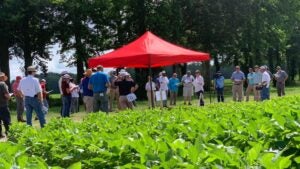
Soybean problem tracking goes digital
Recently, NC State Extension released an online tracking tool called Beans Gone Wild to capture and share in-season crop problems and recommendations.
The new visual mapping tool, funded by the NC Soybeans Producers Association and the NC Agricultural Foundation, uses crowd-sourced field data from public and private partners to document soybean problems (and recommended actions) across the state. Rolling data rotates off every six weeks, providing a current view of problem reports across the state.
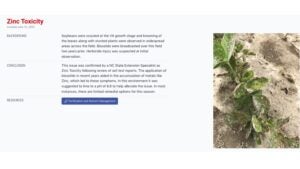
“For soybean producers, it’s useful to know what problems other farmers are facing,” said Jeff Chandler, NC Soybean Producers Association Research Coordinator. “In the past, we didn’t always have timely or accurate information on what’s occurring where. This tool will provide access to real-time problem identification that can be synthesized with Extension recommendations to provide better decision support.”
Beans in beta
Initially, a core group of NC State gatekeepers will create and filter crop problem submissions based on field reports from agents, specialists and agronomists. In this beta-testing phase, the team wants to throttle data timeliness, prevent excessive duplication, and develop a consistent protocol.
Initial data contributors include crop consultants Al Averitt, Matt Winslow, and Stan Winslow; NC Soybean Producers Association Research Coordinator Jeff Chandler; soybean Extension specialists Wes Everman, Dominic Reisig, and Rachel Vann; NC State Extension agents, led by Rod Gurganus; and the NC State Plant Disease & Insect Clinic.
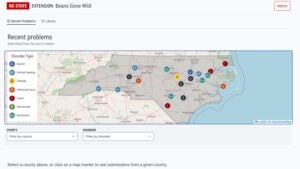
Thin crop margins make for high-stakes decision-making. Crop consultant Al Averitt prizes a collaborative approach.
“It is a very rare event when I make decisions solely upon my own knowledge,” Averitt said. “Usually, decisions are based upon training, experience and discussions with others I trust. It is a good thing when a consultant has access to experts in real-time. Now, the Beans Gone Wild tool will allow these daily situations to be shared with as many farmers as take the time to check in with the app.”
Since the biggest roadblock has been time, the project funds a crop science graduate student, Lilly Bunch, to aggregate data and keep the dashboard fresh.
“This tool has a strong community of supporters and project team members,” Bunch said. “I look forward to seeing this valuable tool coalesce for the industry and shape my own field research comparing determinate and indeterminate soybean varieties.”
The team plans to add contributors across the state over time.
A teaching and training tool
Beans Gone Wild launched for the 2023 season in March and is catching traction. One of the initial benefits has been research validation.
“Already, we’ve seen how field data reinforces what we know from research,” Vann said. “That a cool spring can synergize early season issues like herbicide injury or seedling disease.”
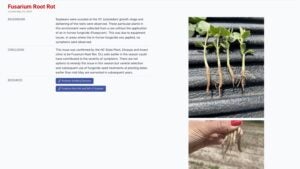
But the accumulating data is also an educational goldmine both in the field and the classroom.
The statewide monitoring tool offers a unique training opportunity for new extension agents and crop consultants to watch issues happening in real-time. And as the library builds, all stakeholders can benefit by reviewing historical issues before the season begins.
As a public site, Beans Gone Wild also has value for growers, alerting them of regional issues and offering resources for follow-up. And in the classroom, agronomy students can use the database for deep dive study or practical examples for class projects.”
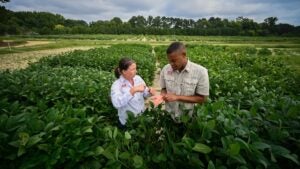
Beans 2.0
Vann is proud of the team’s successful project launch and says their intention was to start lean and manageable. But she already has ideas for improvements.
“We know stakeholders want simplicity in the usability of the dashboard, so we will keep it streamlined and simple. But we plan to add collaborators, and potentially other crops, over time.”
The team also plans to connect the tool to social media with new reports triggering posts to alert followers.
“There is a great opportunity to leverage our strong network and collaborate across the soybean sector. In the end, our goal is to contribute to a well-informed North Carolina ag community.”
Want more pack impact?
Crop and Soil Sciences’ research impacts farmers, students, and NC citizens through innovations in food, feed, fuel, and fiber. Follow how our discoveries affect agriculture and environmental science by joining this weekly newsfeed.
If you are a student interested in agronomy or crop production, investigate our undergraduate and graduate degree programs. Then join a guided email tour of the department and university.
This article was originally published on cals.ncsu.edu and is posted here with permission.


